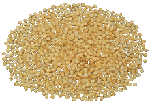BULB ONION
- Bulb onion Allium cepa
- Lily family (Alliaceae)
Bulb onion - is perennial plant ( two-year-old plant).
- Bulb in diameter is 15 cm, it is filmy. Internal skin is dry, yellow, but sometimes violet or white, internal skin is fleshy, white, greenish or violet are situated on shorten stalk where on the fleshy skin situated sprouts that gives the beginning for new bulbs.
- Leaves are bluish-green. Flower bolt can be in a height of 1,5 cm, that ends with umbel.
- Flowers are situated on long flower-stalks. Flower envelope has greenish-white colour, in diameter it is 1 cm. It has 6 petals, 6 stamens, pistil with three-celled ovary. Sometimes inflorescence except flowers has little bulbs.
- Fruit is capsule contains 6 seeds.
- Seeds are green, small, ribby, wrinkled. It bears blossom in June-July. Fruits ripe in August.
Bulb onion came from the mountain regions of Central Asia, where relative varieties still grow. N. Vavilow considered that cultivated onions started to form in Afghanistan, India and in close countries. From these countries onion spread to Persia, Ancient Egypt and Greece, Rome, and Europe; on the East to China, and Far East. It is one of the oldest crop that was known in 4 thousand BC. Some varieties of bulb onion were grown in Ancient Greece; Slavic tribes also grew onion at the territory of modern Russia more than one thousand years ago. The most popular onion became in Rus in 12-13 centuaries. Onion contains protein, saccharose, cellulose, mineral salt ( 18 chemical elements), organic acid, ferments, vitamins C, vitamins of B group, carotene, phytoncids of essential oil give onion specific taste, flavor and smell. Fresh onion works up appetite, intensify exudation of gastric juice, that's why it is used for cooking different appetizers, it also can be consumed as fresh, boiled, fried, marinade, dried, or together with vegetables, meet, fish.
The history of bulb onion started many years ago. They thought that onion became cultivated crop 4 thousand years ago. It happened in Asia, on the territory of modern Iran or Afghanistan. Onion images were found on the pyramids of Ancient Egyptians. There are a few words about this plant in Sumerian writings and in The Bible. In Ancient Rome it was grown for army needs by specially educated people. Even at that time people knew about onion curative properties. It was considered as an universal treatment agent and modern medicine also believes in that. Onion is very useful when you have arteriosclerosis and heart disease, especially if you consume products with a high amount of fats. Onion has ferments that decrease risk of cardiovascular disease. Regular consumption of onion prevent increase of sugar. Moreover onion has many vitamins that are prophylactic agents against cold, cough, running nose and so on. If you have cough it is useful to eat onion boiled in milk. But you need to remember too much is too bad. Specialist from Institute of nutrition of Academy of Medical Sciences think that one men should consume about 7-10 kg of onion per year. People who have difficult kidneys diseases or ulcer of stomach or duodenum shouldn't eat onion as it can be very dangerous.










